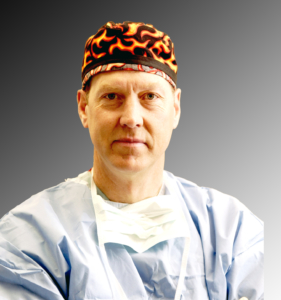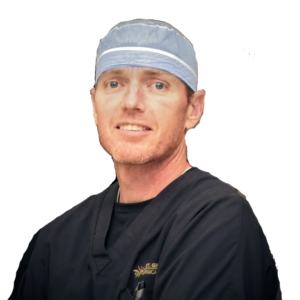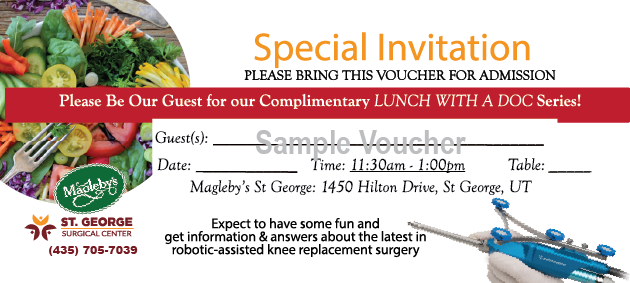Do you need a total knee replacement? Or will a partial do just fine?

By Maria Todd
Director of Business Development at St George Surgical Center
Unicompartmental knee arthroplasty (UKA) is a treatment option for patients with knee osteoarthritis isolated to a single compartment. In comparison with total knee arthroplasty, UKA preserves bone and ligaments and can result in shorter hospitalization and improved patient satisfaction. However, current literature indicates that the success of UKA depends on a variety of factors including patient selection, implant design, component alignment and fixation, and soft tissue balance. It is challenging to obtain correct implant alignment using standard instrumentation, which has been shown to result in outliers beyond 2° of the planned alignment in as many of 40–60% of cases.
Robotic-assisted systems are designed to improve a surgeon’s ability to accurately achieve the desired limb and component alignment, optimize soft tissue balance, control the joint line and restore normal knee kinematics (motion) in UKA. Several types of robotic-assisted surgery have been available in orthopaedics for nearly 25 years. Current robotic-assisted systems often use various navigation principles augmented with the technology of robotic bone preparation, allowing the surgeon to conduct a UKA based on preoperative 3D images or image-free intra-operative planning. It is estimated that 15–20% of UKA surgeries in the United States are performed with robotics assistance.
But in Southern Utah and the NV-AZ-UT tristate region, only one robotics-assisted surgical system is available to perform partial knee replacement: the NAVIO◊ robotics-assisted surgical system now available at St George Surgical Center at 676 S Bluff Street, in St George, Utah.
A historical perspective of robotics-assisted total and partial knee replacement
Robotics-assisted orthopedic surgery has been performed since 1992, when the Robodoc autonomous system was utilized for total hip arthroplasty. A robotic system for total knee arthroplasty (TKA) was first described in 1993, but it would take several more years until a system for unicompartmental knee arthroplasty (UKA) would be commercialized and used clinically.
Understanding the marketing and advertising adjectives
You’ll often read or hear claims related to the “improved precision and accuracy” that a surgeon can achieve with the use of the robotics-assisted technology, but rarely do the articles explain how terms such as “improved” and “better” are defined. Typically, the primary outcome measurement was the angle of tibiofemoral alignment in the coronal plane, measured by CT scan.
In 2006, an article in the Journal of Bone and Joint Surgery, British Volume reported that in a prospective, randomized controlled trial of 28 knees, all of the group that had UKA surgery using the Acrobot had tibiofemoral alignment in the coronal plane within 2 degrees of the planned position, while only 40% of the conventional group achieved this level of accuracy. But back then, while the first-generation robotic technology substantially improved implant position compared to conventional methods; high capital costs, uncertainty regarding the value of advanced technologies, and the need for preoperative computed tomography (CT) scans were barriers to broader adoption. That meant that, for the most part, hospitals were the likely investors in the technologies.
Will Medicare and insurance plans pay for robotics-assisted total or partial knee replacement surgery?
Until January 2020, Medicare beneficiaries were not able to have their knee replaced (total or partial) in the outpatient surgical center setting. Now, Medicare not only covers the cost in the ambulatory surgical center (ASC) setting, Medicare encourages having your knee replaced in the ASC setting unless there is a compelling reason to have the procedure done in the more costly full-service hospital setting.
In Southern Utah, the only place you can have a UKA performed with the NAVIO◊ robotics-assistance to spare the undamaged part of your knee is at St George Surgical Center. Currently, there are only two surgeons qualified and certified by the manufacturer to use the NAVIO◊ surgical system: Drs Michael Manning, and Greg Hicken.


As a result of the clinical advantages of the newer technologies such as NAVIO◊, these newer robotics-assisted image-free technology optimizes both implant position and soft tissue balance, without the need for preoperative CT scans and with pricing and portability that make it suitable for use in an ambulatory surgery center setting, where approximately 40% of these systems are currently being utilized.
At St George Surgical Center for patients who are not covered by Medicare or other insurance, St George Surgical Center offers a bundled, all-in transparent cash price of only $14,990. This price includes the implant, surgeon and anesthesia fees, and facility fees if you pay in full on or before the day of your surgery.
Self-insured employers and unions that use a network that has not yet contracted with St George Surgical Center are able to contract with the Surgery Center at that same $14,990 price if they are willing to agree to SGSC’s streamlined payment terms and conditions in a direct contract or through their TPA.
In fact, many self-insured employers have done just that. Because they save so much over the rates they pay at the hospitals under contract in their existing networks, the surgeons using the NAVIO◊ at St. George Surgical Center now treat patients from many states and Canada under these direct-with-employer and direct-with-union arrangements. And many self-insured employers and unions are so thrilled at the savings realized that they also tend to waive the required deductible and co-insurance for plan members as well as pay for their flights and hotel expenses. With the NAVIO◊ robotics-assisted surgical system, total and partial knee replacement patients are usually released to travel back home within three business days and can have their physical therapy in their hometown.
What is different about partial knee replacement?
The rationale for advancement of robotic technology for isolated medial or lateral knee arthritis stems from the recognition that while UKA is effective and durable when components and limb are well aligned and soft tissues appropriately balanced, they are less forgiving of even slight component malalignment of as little as 2° to 3° and prone to premature loosening or wear in those circumstances.
Currently, an estimated 15% to 20% of UKA surgeries are being performed with robotic assistance. And in Southern Utah, the other robotic systems currently available are not able to perform partial knee replacements.
How long have robots been used for total and partial knee replacement?
One robotic technology first used in 2006 (Mako, Stryker) reported a 130% increase in robotic volume from 2011 to 2012; in comparison, the NAVIO◊, first used in 2013, reported growth of 480% between 2013 and 2014, due to its improved cost structure, ease of use, smaller footprint, image-free platform and applicability in ambulatory surgery centers demonstrating the growing popularity of robotic technology. Further, a recent analysis of potential market penetration over the next decade published by Medical Device and Diagnostic Industry (http://www.mddionline.com) projected that nearly 37% of UKAs and 23% of TKAs will be performed with robotics in 10 years.
Contrast and Comparison of robotic systems
Two main categories of robotics: Autonomous and Semi-autonomous
Autonomous systems involve pre-programming the system with parameters that define the amount and orientation of bone to be removed, after which the system prepares the surfaces independent of surgeon control, other than having access to a “shutdown” switch. As of 2016, there were no autonomous robotic tools approved by the US Food and Drug Administration (FDA) for knee arthroplasty.
Semiautonomous systems such as the NAVIO◊, involve the mapping of knee anatomy landmarks and determination of alignment indices, which also defines the volume and orientation of bone to be removed. While the systems remove bone and cartilage within the pre-established parameters, the robotic tools are controlled and manipulated by the surgeon.
So no, he doesn’t read the paper or go to the doctor’s lounge while the robot performs your surgery!
The advantages of the NAVIO◊ robotics-assisted surgical system over its competitors
Preoperative CT Scan Expense: Over the past few years, the requirement of a CT scan has proven problematic and costly. Many employers, unions, HMOs and PPOs and insurers have taken to denying coverage for additional studies used for preoperative planning, giving rise to surprise bills for patients or resulting in denied claims the hospital must absorb. While advance negotiated bundled payment arrangements (such as St George Surgical’s $14,990 price) gain popularity with insurers and cash pay consumers and self-insured employers, the systems that still require use of costly preoperative imaging is being viewed as “outdated” technology.
Preoperative CT Scan Radiation Exposure: Another consideration is that there is a growing concern regarding the risk of radiation exposure from CT scans (equal to about 48 chest x-rays) that makes image-free technologies, such as NAVIO◊, the preferred alternative for patients, healthcare providers and third-party payers, alike. According to Dr Hicken, many patients may proceed to surgery without the CT scan. In the rare instance the CT may be required, it will be defensible as to medical necessity, and if necessary, appealed to try to overturn the denial from a health plan or insurance company.
For UKA, the NAVIO◊ robotics-assisted surgical system safeguards against inadvertent bone preparation by modulating the exposure or speed of the handheld robotic bur. Compared to conventional UKA, robotic assistance has consistently demonstrated improved surgical accuracy, even through minimally invasive incisions.
As with other surgical procedures that involve minimally invasive incisions, using the robotics-assisted surgical system usually results in quicker healing times and lower complications rates. So why don’t we see every health facility in Utah adopting robotics-assisted technologies? Lack of surgeon competency and qualification is one reason, and the other is the cost to invest in the technology that has been well-documented.
Surgeons must be specially trained and certified to use the robotics-assisted technology. In Southern Utah, few orthopedic surgeons have achieved certification and competency using the NAVIO◊. While several have surgical privileges at SGSC, they simply haven’t, made requires commitment and time to use the NAVIO◊robot. Most still do their knee replacement surgeries the conventional way which, as stated earlier in this article, has been shown to result in outliers beyond 2° of the planned alignment in as many of 40–60% of cases leading to post-operative dissatisfaction by the patients, .
Before January 2020, the constraint was a chicken and egg problem. Many facilities wouldn’t buy a robot unless the surgeons made a clinical case for robotics technology, agreed to the make and model of robot, and were willing to commit the time to master its use. Health system CFOs must also be able to make a business case to defend the investment. When the trajectory is that total and partial knee replacement cases are going to be performed in the ASC setting, the investment required to buy the robot when case volumes are anticipated to decrease makes the investment a tough sell for a hospital executive.
Another advantage to having your knee replacement surgery done in St George is the reduced risk of complications associated with altitude. Recent research published by the American Academy of Orthopedic Surgeons indicates that knee (hip and shoulder too!) replacement surgery performed at altitudes of greater than 4000′ above sea level come with a 40% increased risk of deadly blood clots that can travel to the lungs (pulmonary embolism) within the first 30 days after surgery. That implicates Denver, Albuquerque, Salt Lake City and even Cedar City among other places to have your knee replaced in the US and Canada, and many international destinations.
Why SGSC chose the NAVIO◊
St George Surgical Center chose the NAVIO◊ for several reasons: surgeon preference for the image-free system, its ability to perform UKAs in addition to total knee arthroplasty (TKA), its lower cost, a wider array of implant models, and that return on investment could be achieved with fewer cases per year, roughly 25% of the cases necessary with image-based systems.
And since St George Surgical began using the NAVIO◊ in October 2019, one of the most noteworthy advantages to using the NAVIO◊ system has been the increased patient satisfaction and delight related to decreased pain and post-operative recovery and smaller incision size. Also, most patients get through their physical therapy rehabilitation before their conventional knee replacement counterparts have even started.
If you are experiencing knee pain and limitations and would like to discuss your options for robotics-assisted total or partial knee replacement without the added radiation and cost of a CT scan, Call St George Surgical Center today at 435-673-8080.
Learn more about your options at our free Lunch with a Doc sessions at Magelby’s scheduled through May 22, 2020.
To reserve your seat for lunch by calling our RSVP line at 435 705 7039. Check our Events page for details and subscribe to notifications to be the first to receive alerts when we schedule new Lunch with a Doc programs and other local events.

About St George Surgical Center
Located in sunny St. George, in southern Utah, SGSC is a multi-specialty surgical facility, physician-owned and operated.
- • Board Certified Surgeon & Anesthesia Providers
- • Prestigious AAAHC Accreditation
- • Medicare Certified
- • 99.6% patient satisfaction rate
- • Extremely low infection rate, 0.037%(Natl Avg 2.6%)
- • 11,000 sq ft with 4 state-of-the-art surgery suites
- • 23-hour Overnight/Extended Stay facility (the only ASC in Southern Utah with overnight capabilities)
Competitive pricing and excellent customer service for our valued patients and their families.
Learn More...